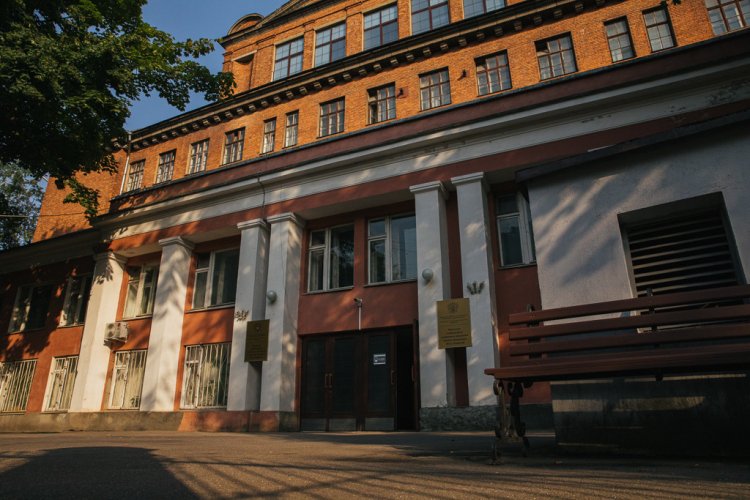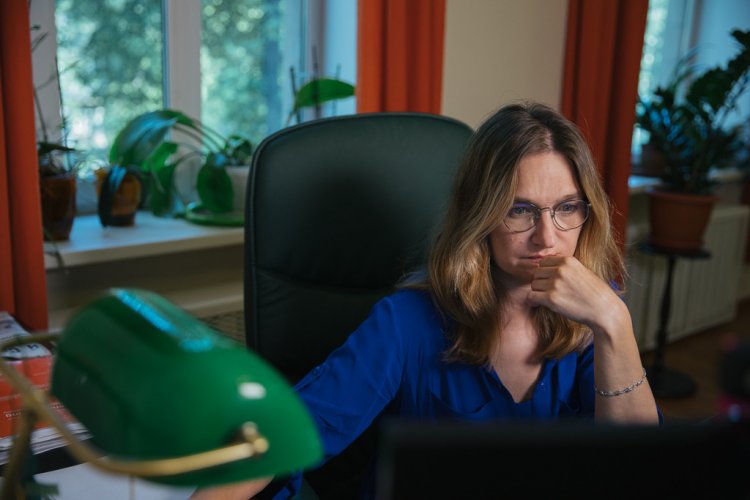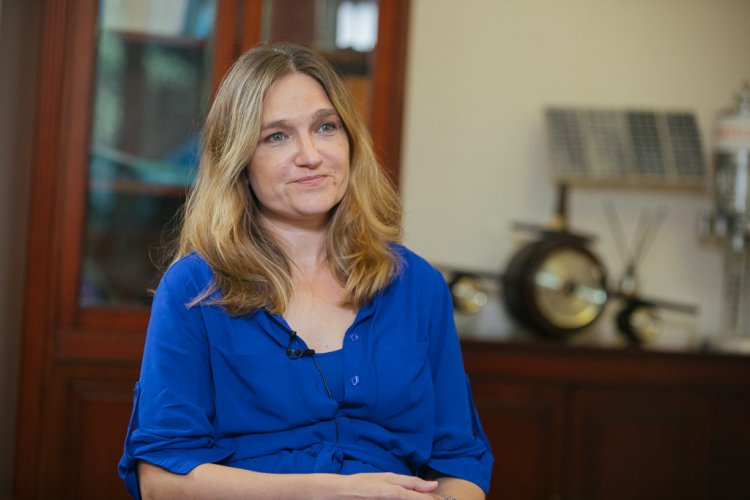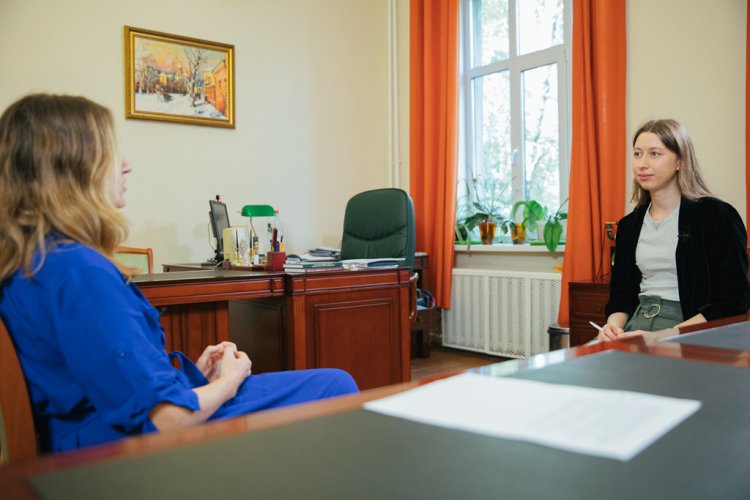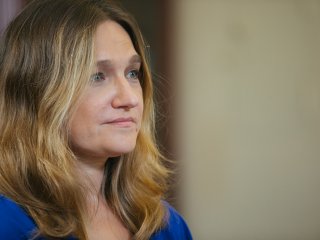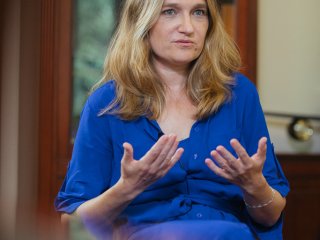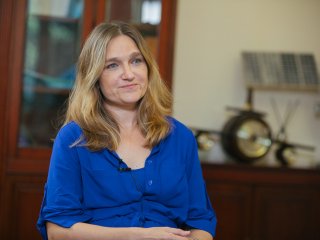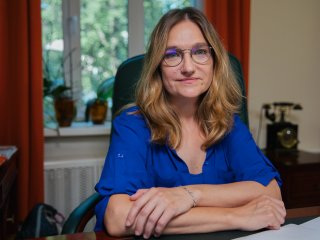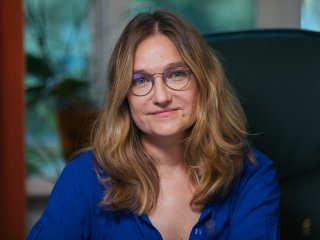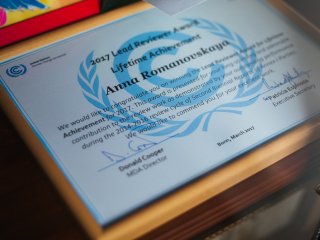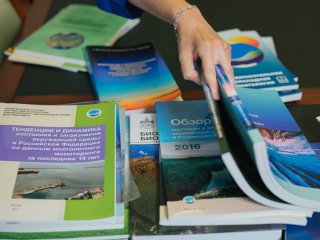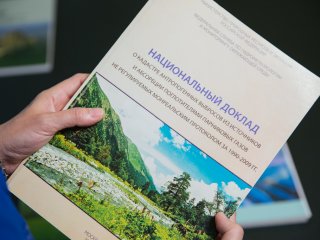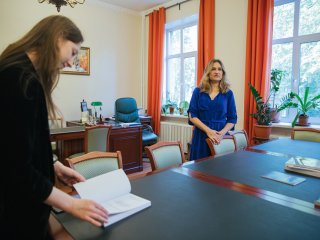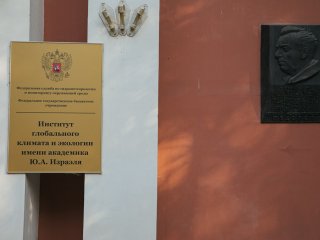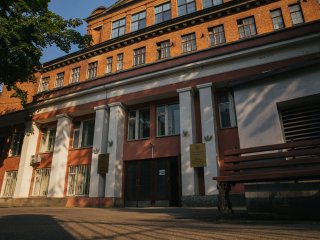Anna Anatolievna Romanovskaya
Photo: Nikolay Mokhnachev / Scientific Russia
“Global warming,” “greenhouse gases,” “Arctic ice melting…” Many environmental terms have become so familiar to us that sometimes it seems that they can be heard from every household device. A change of 1.5 to 2°C in the climate is discussed at the highest levels. Environmental issues also worry ordinary citizens who want to live in a better world and provide their children everything they need for a happy and healthy life. But is it really that important to address these issues, or is it just “information noise” that has emerged as a disaster in many countries? Where did the excitement around the climate agenda come from, why do we need to follow the Sustainable Development Goals, how are greenhouse gases produced, and can a “little man” influence global processes? Read about it in our interview with Anna Romanovskaya, Corresponding Member of the Russian Academy of Sciences, Director of the Rosgidromet Yu. A. Izrael Institute of Global Climate and Ecology
- Anna Anatolievna, could you tell us, please, what kind of research your Institute is engaged in?
- As the Institute’s name implies, the research topics are divided almost in half: climatic and environmental. As for climate, our Institute monitors climate change. The report on climate change that everyone uses and hears and the figures from it that are quoted by the Government and the President of the Russian Federation come from this Institute. For example, when we say that Russia is warming 2.5 times faster. And now it's 2.8. We compile reports and they are sent to the public on behalf of the Federal Service for Hydrometeorology and Environmental Monitoring (Rosgidromet). This is the first block on the climate.
Yu. A. Izrael Institute of Global Climate and Ecology
Photo: Nikolay Mokhnachev / Scientific Russia
The second big block is climate change impact assessment and vulnerability assessment. Since Rosgidromet has about 17 departmental institutes, all the topics are distributed among them. As far as consequences and vulnerability are concerned, we are looking at such sectors as the population and natural ecosystems. The industrial sectors, energy issues are already considered by other institutes. So, when you see such information products from Rosgidromet as the climate change assessment reports on the territory of the Russian Federation, the major part of the research was conducted at our Institute. But this is an integrated publication.
The third area of climate change that everyone is familiar with and is in the focus of our Institute’s work is preparation of national reports within the United Nations Framework Convention on Climate Change (UNFCCC), the Kyoto Protocol, the Paris Agreement, all these things are done here. The annual national anthropogenic emissions and absorption of greenhouse gases inventory is also prepared here and then sent to Rosgidromet; they coordinate it with other ministries and then the Ministry of Natural Resources and Environment approves it. Every year on April 15, this report is submitted to the Secretariat of the UNFCCC. Now this is an international, very serious document. And of course, at this time it is also a reference book that guides both policy and economy in our country.
Environmental Block. We are mainly engaged in the so-called background monitoring, the monitoring of the natural systems state. Basically, this is a network that is based on biosphere reserves. We monitor whether there are any background changes in various natural environments. And this kind of monitoring has been going on for many years.
Another important direction in the environmental block is transboundary transfer. The relevance of this problem can vary from region to region. When the convention on transboundary transfer began, it was relevant for the EU border. Now the relevance has moved to the Chinese border. This area is also politicized, so there is a constant need for reliable information.
Just like all Rosgidromet institutions, we prepare some kind of summary, analytical reports. In particular, products on the review of environmental pollution in the Russian Federation – this is an annual review with information collected from all subordinate agencies of Rosgidromet. The final form of this review is compiled at the Institute.
The directions and specialists are very diverse. We invite everyone to our Institute. It's very interesting here, we're always working at the intersection of different sciences and fields. I am honored to be the director of this institute.
Anna Anatolievna Romanovskaya.
Photo: Nikolay Mokhnachev / Scientific Russia
- Anna Anatolievna, nowadays there is a kind of trend for ecology. Do you think that more attention is actually being paid to environmental problems? The UN Framework Convention was concluded in 1992, the Paris Agreement in 2015. Now it's 2021, and it seems that interest in ecology is only growing. Do you think this is the case or the interest in environmental issues was there before?
- You know, the situation in our country is a little different than in others. And, in general, attitudes toward ecology differ across countries. Because when countries are poor, people do not have time to think about ecology. They have to think about the ways to survive. And when a country and its people start thinking about ecology, it's a very positive sign. It means that we have crossed that line where we must think about how we will survive and how we will raise our children, and begin to think about some global issues: how the children will live in the future and how we can help them. It is clear that this direction has been developing for a long time: both in the European Union and in the USA. The birth year of this subject is 1972, the year of the Stockholm Conference on the Human Environment. Nevertheless, in our country, this phenomenon is periodic: when we are better off, we remember about chemical pollution; when things are worse, in the 90s it got really hard, for example, we don't. And now there is a second breath. This year, the climate has become particularly relevant. And suddenly everyone in our country began to understand, stopped saying that the climate is changing because it is always changing and it has nothing to do with humanity. Suddenly we realized that we do have an impact and can do something about it and, most importantly, the government began taking action. And it seems to me that in general the population has started to react.
I am trying to say that this is not just some trend, but a global trend that is inevitable. And climate and environmental issues are set in the context of the Sustainable Development Goals, transition to sustainable development of the country and our lives.
I think, the fact that it has begun is a very positive sign. The most important thing is that all this should be constructive. It should not turn into “foam” or “dust” of our various decisions against the backdrop of excitement, but rather we should be able to contain the excitement to a certain extent and build the right line. I hope this will work out.
Photo: Nikolay Mokhnachev / Scientific Russia
- Climate is a fairly global phenomenon, how exactly can people affect it?
- We used to hear a lot of opinions, including those in Russia, that humanity is too small to be able to affect the climate. And we kept trying to frame this as an argument that “something is going on, but it has nothing to do with us.” It turns out that the impact we do have is already enough to move things a little bit. While we can't fundamentally change it, we keep burning fossil fuels, which are the biomass that has been accumulated over hundreds, millions of years, turning into oil, gas, coal. Things that the biosphere has been disposing of for dozens of millions of years, it's all gone in a year, two decades. We go from one deposit to another. It is clear that we have started returning small gas constituents to the atmosphere by such quantities. Of course, we have not changed the very fact of the greenhouse effect. But we have changed the climate a little bit – it became a little warmer. If the average temperature on the planet was 16-18°C, now it's 19°C, and it may even become 20°C. And then the question is: how serious is this and what could it bring about?
Just today, August 9, 2021, the day we met, there was a big presentation of the first volume of the Sixth Assessment Report on the physics of climate change prepared by the Intergovernmental Panel on Climate Change (IPCC), with new estimates published in the report. This is a synthesis of the latest, most recent information on climate change, where it is confirmed once again that human influence and anthropogenic gas emissions are the main cause of our impact on the climate.
- What kinds of greenhouse gases are there?
- In general, if we talk about the natural greenhouse effect, the main greenhouse gas is water vapor. However, given the fact that its cycle in the atmosphere is very short and the amount of water vapor in the atmosphere is enormous, humanity can have very limited impact on the water cycle. Practically can't. Therefore, water vapor is not considered an anthropogenic cause of climate warming.
Anthropogenic greenhouse gases are carbon dioxide (СО2), methane (CH₄), nitrous oxide (N2О), perfluorocarbons, hydrofluorocarbons, sulfur hexafluoride (SF6), now NF3 – trifluoroisot is also added. There are many small constituents: the so-called precursors – substances that can be sources of greenhouse gases, sometimes they are also counted, but, as a rule, they are not included in the number of major greenhouse gases.
- And all these greenhouse gases are caused by different things. Right?
- Yes, absolutely right. If we talk about the latest chemicals, it's basically only industry. Just the sources of different industry types produce both hydrofluorocarbons and perfluorocarbons. And if we talk about the main greenhouse gases, the three most talked about are CO2, CH4, N2О, they are present in almost every category of human activity. First of all, they come from burning fossil fuels, they are present in activities related to land use, from agriculture (fertilizers, livestock – there's methane) and in the waste sector. So almost all human activities, in one way or another, are related to all three of these major greenhouse gases.
- How far does the effect of greenhouse gases extend? For example, this summer the smoke from the fires in Yakutia reached Irkutsk! Aren't the winds carrying the smoke in the opposite direction, to the Arctic? And to what extent can the fires affect the Arctic areas?
- That's a very interesting question, and it's great that you asked. There is a misunderstanding about how greenhouse gases are emitted in the first place. Actually, all greenhouse gases are well-mixed in the atmosphere. And even though there are certain local sources, almost immediately, within days, weeks, all these concentrations are mixed. That's why we say that it's impossible to reduce emissions in one country in such a way that the country will change the climate on its own. Because everything gets mixed up so quickly, we all have to act in concert.
Black carbon, a climatically active, short-lived substance that everyone is familiar with, is a component of soot – pure, elemental carbon. And in the context of Arctic problems, its emission, transport and deposition on the snow, ice surface, can lead to warming and additional warming in the Arctic. This is why it is classified as a climatically active substance, although it has many different effects. It can act as a coolant in the atmosphere. We all know the situation, when the sun shines on dirty snow, it begins to thaw actively around black spots. The same effect can happen when such black carbon falls on the snow or ice of the Arctic. Then active thawing begins and, among other things, a physical parameter such as albedo, when a surface reflects incoming solar radiation, is reduced. Both pure snow and ice reflect more than snow and ice covered with gray and black dots.
In the Arctic, this is a real problem. And we once counted the biggest sources of black carbon coming into the Arctic. What from? We used to blame Russia, thinking that if we don't extinguish fires, the Arctic gets warmer because of us... We did this study: we looked at how much black carbon is emitted even from the most intense fires, and even assuming that the emission goes to a height of over 3 km and atmospheric transport begins, it turned out that summer conditions lead to the fact that fires in Yakutia give no more than 10% of black carbon occurring from fires to be transported to the Arctic.
I mean, there is a problem indeed, it is related, among other things, to the climate, but I would call wildfires an environmental disaster, which, firstly, makes people feel suffocated. We see that it's getting darker during the day, that it's soot. We [residents of Moscow] remember 2010 and this whole situation. And when we say that we need to put out fires, it's not because forests absorb carbon or because soot flies to the Arctic, but because our natural ecosystems need to be protected in order to preserve the range of ecosystem services they provide. And it's not just about climate services.
The question of learning how to evaluate these ecosystem services arises, which is something that almost nobody in our country knows; there are literally only a few such specialists in our country. We met with them; it was very interesting to try to evaluate the functions of ecosystems in monetary terms. This is something absolutely amazing. When we talk about whether it is profitable to send an expensive helicopter to try to put out a fire or not, the forestry experts say that the cost per hectare in that place is 700 rubles. Because there are only two or three trees worth selling, the rest of the trees cost nothing. And sending a helicopter would cost, say, three thousand rubles per hectare. And it is unprofitable as long as there is no threat to the community. But if we were to look beyond the commodity value of timber and correctly account for this forest area, we could evaluate all those ecosystem services: biodiversity, water regulation, and atmospheric purification. If we were to evaluate all this correctly in monetary terms, we would already look at it this way: “This hectare of forest gives 10 thousand rubles just for the fact that it is alive. It's worth 3 thousand to put it out. So, we have to fly in and put it out.” We would change the entire economy; we would give an economic reasoning for our actions. Basically, the whole world has already switched to such economic approaches. So, I would say again that the problems are much broader than that. It's not just climate, it's not just greenhouse gases, it's not just carbon sequestration. It is our health and sustainable development of our country: it is about conserving the resources that we have, including natural, energy, and human resources.
- What is being done to promote the Sustainable Development Goals in our country and in others? Is it possible to achieve them?
- So far, I do not see any coherent concept for the implementation of sustainable development in Russia. We have fragmented strategies in each industry. They include, among other things, the ideas of Sustainable Development. But I have not seen any “umbrella program” that would be dedicated to regulating the interaction of these industry strategies. Yes, there are indicators used to evaluate the fulfillment of all goals and objectives (there are more than 160 of them). The Federal State Statistics Service (Rosstat) has implemented them. Last year, the Russian Federation prepared its first national review of the Sustainable Development Goals. Many public, scientific, and governmental organizations took part. We prepared a review where we reported on what we were doing. But so far, we have no specific strategy on sustainable development. I cannot say how things are in other countries, frankly speaking, I just haven't checked on it.
At the moment, we are now heading somewhere between the economy and the climate... I think we need to focus on all of the Sustainable Development Goals in order to keep a reasonable balance. Maybe we could call them differently, some goals are less relevant to us, some are more. We need to understand how to work with them, but not only with a list of indicators, but also with some plans to improve these indicators. I would like to see this and I think we will get there.
- Anna Anatolievna, during the pandemic year with the biggest restrictions, when people were on self-isolation, there were fewer carbon dioxide emissions, because there was less transportation. Did the climate change? Has it somehow affected the environment? Has it improved over that time?
- As for the climate, such estimates have been made. And when we looked at it on a daily basis, in 2020, at the time of the lockdown, compared to 2019, the figures differed 30 and 40 times. When we looked at the recalculation for the year (because at the end of the quarantine we started to increase production sharply, the economy immediately went into a sharp growth, which had already surpassed these same 2019 figures), the World Meteorological Organization estimated the pandemic impact on greenhouse gases; it turned out that we did reduce emissions a bit in 2020, but not atmospheric concentrations, they continued to grow. It's just that atmospheric emissions in 2020 were about 5-7% lower than they were in 2019. So, the rate of increase in atmospheric concentrations was a little bit slower. Nevertheless, it has continued. And now, the IPCC Sixth Assessment Report and the WMO data show that the atmospheric concentrations of greenhouse gases are steadily increasing. And this lockdown has not had any effect on the growth of atmospheric concentrations.
The ecological situation was really improved. We watched absolutely amazing videos from different cities when animals were entering some major cities. And the satellite data showed that certain pollutants were in green and in weak yellow zone, and at the end of the pandemic, some of them returned to the red zone again. It shows that we are affecting the environment and you can feel it. We can regulate it. But it happened because we were in decline, we were depressed, but not because we've done any conscious activities to evolve and reduce emissions so far.
- Is it possible to grow the economy and reduce emissions at the same time??
- Yes, it is definitely possible. First of all, we have the experience of the European Union, which demonstrates sustainable GDP growth and an equally sustainable reduction of greenhouse gas emissions. This is an interesting story for the Russian Federation because if we use our natural advantages – natural and energy resources – more carefully, we do not need to do anything else. Production modernization and energy efficiency increase in the housing and utilities sector in the first place could bring enormous reductions in greenhouse gas emissions. We also need to introduce carbon-efficient technologies in agriculture and preserve forest ecosystems. These are the directions that the Russian Federation will follow, perhaps slowly and unwillingly, but we are going in this direction because this is the only way our country can develop sustainably. It could have a so-called “co-benefit” – a collateral benefit that we will reduce our greenhouse gas emissions and become a carbon-neutral country. And we could be one of the first. And we could move even further into the negative values, take the lead in this field.
Of course, an economy can develop at low levels of greenhouse gases, but it will be a slightly different economy. And in order to create it, we need to create the conditions for its development. We need to push things that may not be at the forefront right now, and give these low-carbon technologies a chance to develop and become cheaper and more widely adopted, and try to trade these technologies, too.
A behind-the-scenes photo of the interview with A. Romanovskaya.
Photo: Nikolay Mokhnachev / Scientific Russia
A behind-the-scenes photo of the interview with A. Romanovskaya.
Photo: Nikolay Mokhnachev / Scientific Russia
- There are many different actions and movements supporting environmentalism, and some people support the radical ideology of “Childfree.” How much does childlessness really contribute to the environment, is it true that the fewer people, the fewer emissions, or do these thoughts have no scientific basis at all?
- I would say that there is no need for science here. It is clear that the less population on the planet, the less emissions there will be. There will be less “car racing,” less heating, fewer computers, and so on. The problem that we have today is primarily due to the huge population growth that occurred on the planet in the 20th century. It has now slowed down a little bit. Will universal childlessness be the solution to climate problems? – Of course not. And in general, many of the trends that we see, have little to do with solving environmental problems. It is something that started our conversation: it's a trend, something that people are willing to go for, something that people are willing to listen to.
We need to introduce other measures, we need to learn to live sustainably, while not eliminating half the population by certain radical means. Children have the right to be born, have the right to live on this planet. No one is saying that we should not regulate the birth rate. It's an important issue, we just don't see it here, but it's clear that it is important for poor countries. And so, we're back to the goals that are embodied in the Sustainable Development Goals. If we equalize living standards in all countries of the world, the population will live in roughly the same conditions. With access to the same benefits, and roughly comparable levels of income. Then the excessive birth rate in certain places will be reduced. And in others, people will not be left without children for the sake of some “ecological ideals.” Our goal is to learn to live in harmony. There are three directions in sustainable development: social, economic, and environmental sustainability. And none of these directions should be to the detriment of the other. We will learn how to do this. We have already started moving in this direction.
- Are there any leading countries in greenhouse gas emissions?
- Of course, there are such ratings. They are constantly published. In terms of greenhouse gas emissions, we are fourth. China comes first in terms of greenhouse gas emissions, the United States, the European Union, then we or India, if we also take into account absorption of greenhouse gases. If you look at the top ten countries in terms of greenhouse gas emissions, these are the countries that really give more than half of the world's emissions. And a reduction in these countries would immediately have a greater effect, than if we were to reduce emissions in those countries that contribute a tiny fraction of a percent to global emissions. Nevertheless, the Paris Agreement is structured in such a way that we are no longer defining who is bigger and who is smaller. In addition, the leaders are also changing. When the UN Framework Convention began, China was nowhere near the leaders in greenhouse gas emissions. Now it is the leader. The Paris Agreement introduced the “Let's all work together” principle. And we are beginning to move toward universal emission reductions, yet slowly and weakly. We have all heard that those goals and commitments that countries have made are not enough to meet the goals of the Paris Agreement to limit the global temperature rise to 1.5 – 2˚C. (We can forget about 1.5˚C, we need to focus on 2˚C.) Countries have begun to move in this direction. Many countries are now reinforcing these goals. Now the U.S. administration has also changed. Joe Biden's administration, unlike Donald Trump's, is looking in a very different direction. Their inclusion in the climate agenda has intensified these activities in general around the world. Many countries have begun to reconsider their goals and “increase their ambition.” I hope that Russia will reconsider the goal that we declared in 2019, too. It is very weak, of course. It does not speak of reducing emissions, but rather of increasing them, so let's hope that Russia will also join this trend. And gradually, we will be able to solve everything.
- Is it fair to decide the pace of development, decide who has to cut back on greenhouse gas emissions by a lot? Will everyone develop their economies quite calmly and evenly?
- That will probably never work. This is a very hot topic in the negotiations, because it's clear that poor countries don't even all have electricity and they're being forced to reduce their greenhouse gas emissions. That means they can't put a power plant where they want it, because their emissions will go up. So, of course, the developed, wealthy countries have to take the lead. They should make stronger commitments. Developing countries under the Framework Convention, the Paris Agreement, are entitled to technological assistance; it says, “Put up a power plant, here's the technology, here's the financial assistance, but don't make it coal-fired, use some cleaner technology.” They are offered to develop immediately on advanced technologies, for this purpose they are given funding. In addition, countries formulate their own goals. For example, China. We understand that the population in China has a lower standard of living than in the EU or the United States. And China's population still has the right to increase energy consumption in order to reach a comparable level. And this is why China does not set emission reduction targets in absolute numbers. China says, “We will reduce specific indicators. We're going to put more power plants, but we're going to put less coal in them.” So far, we are moving in that direction. When we talk about the fact that there are certain deadlines that are set in the Paris Agreement to reach worldwide, global carbon neutrality by 2050: theoretically, it is possible. Its practical implementation probably won't happen, but who knows. Maybe the technology will develop quickly, too.
Many questions are still left – ecology directly affects the economy and finances of all countries.

